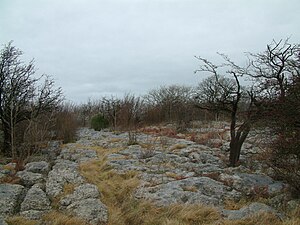Hutton Roof Crags: Difference between revisions
| Line 17: | Line 17: | ||
==Conservation== | ==Conservation== | ||
The hill forms the Hutton Roof Crags Site of Special Scientific Interest and is part of the 'Morecambe Bay Pavements Special Area of Conservation'. A significant proportion of the United Kingdom's | The hill forms the Hutton Roof Crags Site of Special Scientific Interest and is part of the 'Morecambe Bay Pavements Special Area of Conservation'. A significant proportion of the United Kingdom's limestone pavement is to be found on Hutton Roof Crags and the neighbouring Farleton Knott. | ||
Hutton Roof National Nature Reserve is managed by the Cumbria Wildlife Trust,<ref>[http://www.naturalengland.org.uk/ourwork/conservation/designatedareas/nnr/1084456.aspx Hutton Roof NNR], Natural England.</ref> which leases Park Wood and Hutton Roof Common from Natural England and Hutton Roof Parish Council respectively.<ref>[http://www.cumbriawildlifetrust.org.uk/reserves/hutton-roof-crags Hutton Roof Crags]: Wildlife Trust.</ref> | Hutton Roof National Nature Reserve is managed by the Cumbria Wildlife Trust,<ref>[http://www.naturalengland.org.uk/ourwork/conservation/designatedareas/nnr/1084456.aspx Hutton Roof NNR], Natural England.</ref> which leases Park Wood and Hutton Roof Common from Natural England and Hutton Roof Parish Council respectively.<ref>[http://www.cumbriawildlifetrust.org.uk/reserves/hutton-roof-crags Hutton Roof Crags]: Wildlife Trust.</ref> | ||
Latest revision as of 16:20, 7 June 2017
| Hutton Roof Crags | |
| Westmorland | |
|---|---|
 Limestone pavement on the top of Hutton Roof Crags | |
| Summit: | 900 feet SD556775 54°11’29"N, 2°40’55"W |
Hutton Roof Crags is a hill in the very south of Westmorland, standing to the west of the village of Hutton Roof. It has extensive areas of limestone pavement as well as grassland and woodland.
Although part of the hill is grass grazed by sheep, and part is forested, much remains open common land, and it is here that most of the limestone pavement is to be found. In former generations the limestone was extensively quarried for many purposes including building, agricultural fertiliser, and production of millstones, but is now protected by law and it is an offence to remove any. The limestone is over a thousand feet thick, and was laid down during the Carboniferous period some 350 million years ago. The limestone pavements here occupy an intermediate position between the low-lying pavements of Gait Barrows some five miles to the west, and those on Ingleborough, twelve miles to the east.
The name Hutton Roof Crags is from that of the village at its foot, which believed to derive from the Old English for 'Hrolf's farmstead".
Conservation
The hill forms the Hutton Roof Crags Site of Special Scientific Interest and is part of the 'Morecambe Bay Pavements Special Area of Conservation'. A significant proportion of the United Kingdom's limestone pavement is to be found on Hutton Roof Crags and the neighbouring Farleton Knott.
Hutton Roof National Nature Reserve is managed by the Cumbria Wildlife Trust,[1] which leases Park Wood and Hutton Roof Common from Natural England and Hutton Roof Parish Council respectively.[2]
Plants including rigid buckler fern, angular Solomon's seal, limestone fern, and dark red helleborine are to be found on the pavement. The nationally scarce rigid buckler-fern Dryopteris submontana is abundant on Hutton Roof Crags. Blue moor grass is also nationally scarce but abundant here.
Accents
Access is possible via the public footpath running across the north of the fell, but is probably easier through the woods to the south-west.
The extensive low limestone outcrops make the Hutton Roof Crags a popular site for bouldering.[3]
References
- ↑ Hutton Roof NNR, Natural England.
- ↑ Hutton Roof Crags: Wildlife Trust.
- ↑ Hutton Roof Crags on 'UK Climbing Logbook'